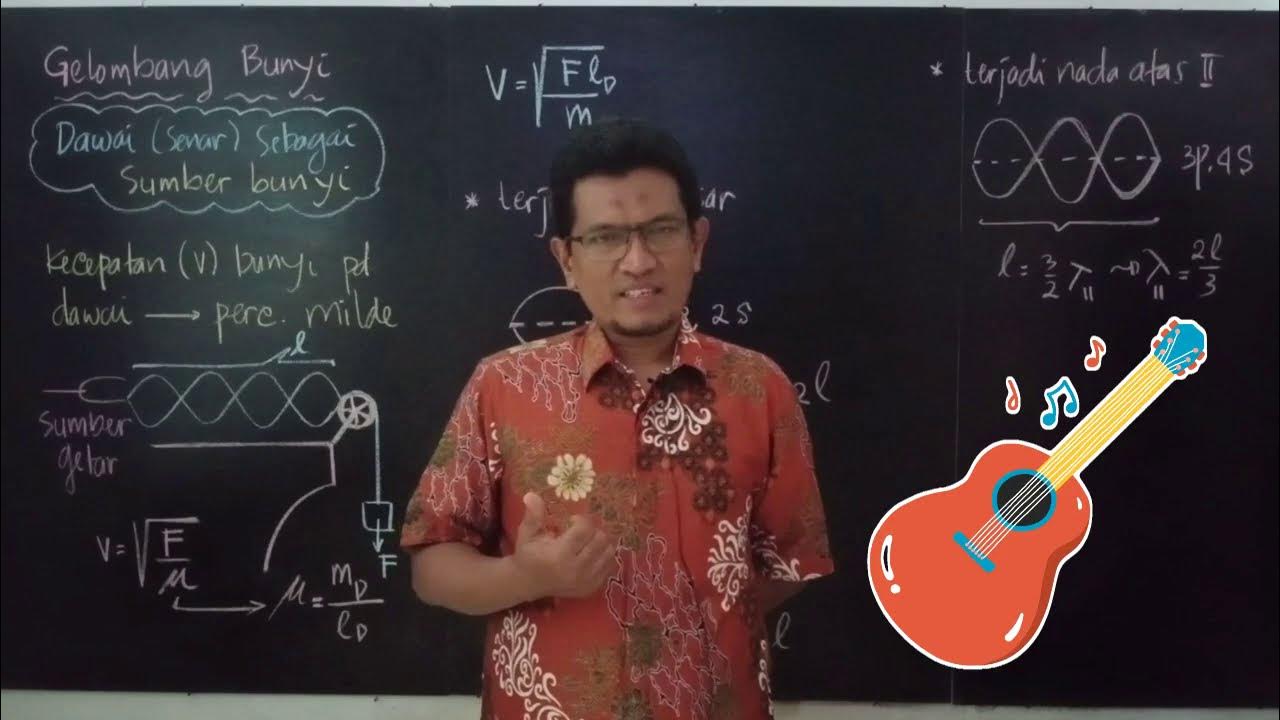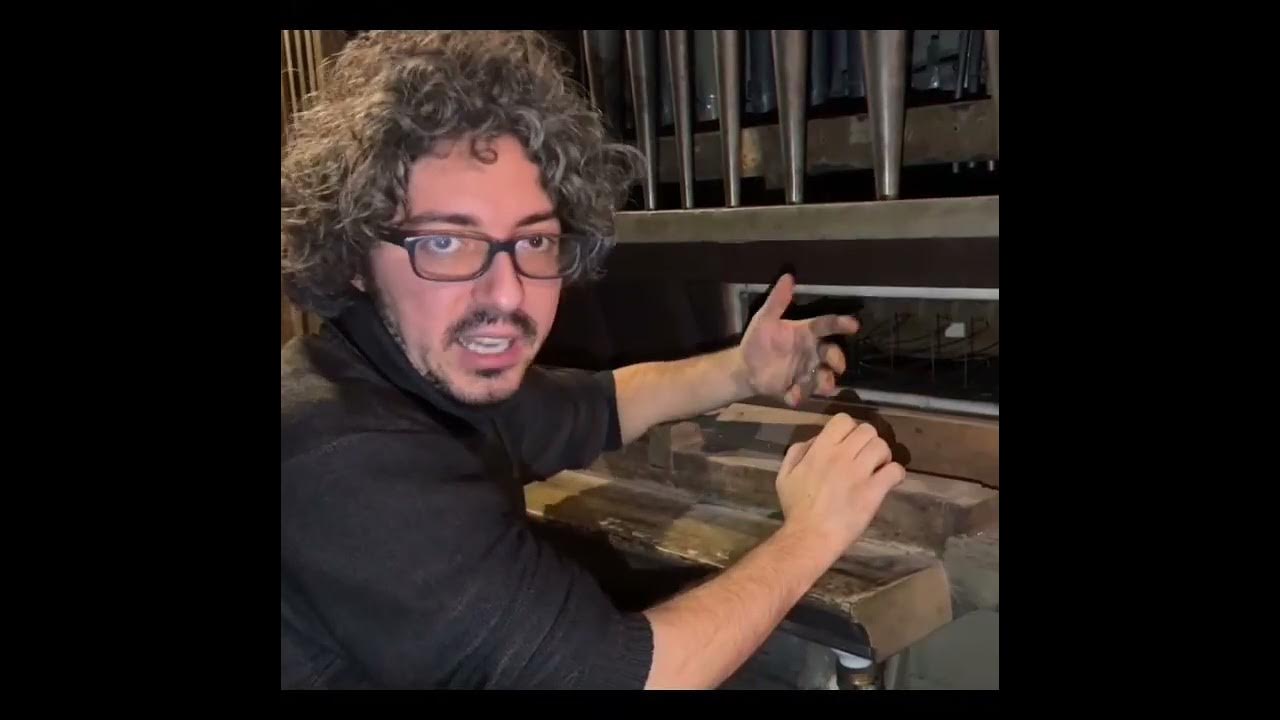Gelombang Bunyi • Part 3: Sumber Bunyi (Dawai, Pipa Organa Terbuka dan Tertutup)
Summary
TLDRThis video explains sound waves through the discussion of three types of sound sources: strings (dawai), open organ pipes, and closed organ pipes. The video covers concepts like wave propagation, nodes, and antinodes, as well as the differences in vibration patterns in these sound sources. Key topics include the behavior of sound waves in strings and air columns, the mathematical relationships for calculating wavelengths and frequencies, and the differences between open and closed pipes. The video offers insights into how musical instruments like guitars, trumpets, and drums produce different pitches through these principles.
Takeaways
- 😀 Dawai (strings) create sound through vibration, with both ends fixed, forming a stationary wave.
- 😀 In string instruments, such as guitars and violins, the two fixed ends lead to different harmonic frequencies depending on the length and tension of the string.
- 😀 For an open pipe (like a flute or trumpet), both ends are free, and the sound is generated by air vibrations through the pipe.
- 😀 An open pipe has a simple harmonic series where the wavelength is related to the length of the pipe (λ = 2L for the fundamental frequency).
- 😀 A closed pipe, such as a drum, has one closed end and one open end, forming a different harmonic series where the fundamental frequency has a quarter-wavelength relationship with the pipe length (L = λ/4).
- 😀 The speed of sound in air is approximately 340 m/s but varies depending on factors such as temperature.
- 😀 The relationship between frequency (f) and wavelength (λ) is crucial in understanding sound production, with the formula f = v/λ.
- 😀 In both string instruments and pipes, the number of nodes (points of no vibration) and antinodes (points of maximum vibration) determines the harmonic frequencies.
- 😀 Harmonic frequencies in strings and pipes are integer multiples of the fundamental frequency, with the pattern differing between open and closed pipes.
- 😀 The difference between 'harmonic' and 'overtones' is essential: Harmonics are integer multiples of the fundamental frequency, while overtones can refer to any frequency above the fundamental, depending on the instrument.
Q & A
What are the three sources of sound discussed in the video?
-The three sources of sound discussed are: vibrating strings (dawai), open-ended pipes (pipa organa terbuka), and closed-ended pipes (pipa organa tertutup).
How does a vibrating string produce sound?
-A vibrating string, like those found in instruments such as guitars and violins, produces sound when it is plucked or bowed. The two ends of the string are fixed, and the vibration forms standing waves.
What is the key principle of a vibrating string's behavior?
-The key principle is that both ends of the string are fixed, creating nodes at the ends. The vibration of the string generates standing waves, with nodes at the ends and antinodes at the center.
How is the wavelength of a vibrating string related to its length?
-For the fundamental frequency (n = 1), the length of the string is half the wavelength (λ = 2l). For higher harmonics, the relationship is λ = 2l/n, where n is the harmonic number.
What are nodes and antinodes in the context of sound waves?
-Nodes are points where the displacement of the wave is zero (where the wave is fixed), while antinodes are points where the displacement is maximum (where the wave vibrates the most).
How do open-ended pipes generate sound?
-In open-ended pipes, like flutes and trumpets, both ends of the pipe are open. Air vibrations inside the pipe create standing waves with antinodes at both open ends.
What is the relationship between the pipe length and the wavelength in an open-ended pipe?
-For the fundamental frequency (n = 1), the length of the pipe equals half the wavelength (λ = 2l). For higher harmonics, the formula is λ = 2l/n, similar to a vibrating string.
What is the difference between a pipe that is open at both ends and one that is closed at one end?
-A pipe open at both ends has antinodes at both ends, while a pipe closed at one end has a node at the closed end and an antinode at the open end.
What are the harmonic series for a closed-ended pipe?
-For a closed-ended pipe, only odd harmonics are present. The fundamental frequency (n = 1) is related to λ = 4l. Higher harmonics follow the pattern: λ = 4l/(2n - 1), where n is the harmonic number (1, 3, 5, etc.).
How do the nodes and antinodes behave in a closed-ended pipe?
-In a closed-ended pipe, the closed end forms a node (no displacement), while the open end forms an antinode (maximum displacement). The wave pattern depends on the harmonic being produced.
What is the significance of the speed of sound in different mediums when studying wave propagation?
-The speed of sound (v) varies depending on the medium (such as air or string). In air, the speed of sound is around 340 m/s, but it can change with temperature. The frequency of the sound produced by vibrating sources depends on the speed of sound in the medium and the wavelength.
Outlines

このセクションは有料ユーザー限定です。 アクセスするには、アップグレードをお願いします。
今すぐアップグレードMindmap

このセクションは有料ユーザー限定です。 アクセスするには、アップグレードをお願いします。
今すぐアップグレードKeywords

このセクションは有料ユーザー限定です。 アクセスするには、アップグレードをお願いします。
今すぐアップグレードHighlights

このセクションは有料ユーザー限定です。 アクセスするには、アップグレードをお願いします。
今すぐアップグレードTranscripts

このセクションは有料ユーザー限定です。 アクセスするには、アップグレードをお願いします。
今すぐアップグレード関連動画をさらに表示

Fisika Kelas 11 - PIPA ORGANA Terbuka dan Tertutup

DAWAI (SENAR) SEBAGAI SUMBER BUNYI | Gelombang Bunyi #1 - Fisika Kelas 11

GELOMBANG BUNYI PART 5 (materi pot)

Animasi Fisika : Gelombang Bunyi dan Cahaya

Kilise Orgu Nasıl Çalışır? Klasik 19.yy İtalyan Orgu'nda Keşfedelim

Gelombang Bunyi 1 - Sumber Bunyi (Dawai & Pipa Organa)
5.0 / 5 (0 votes)
